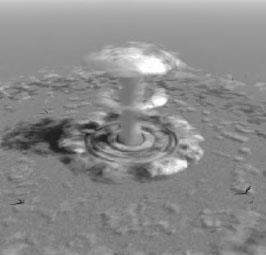At the Heart of the AtomIntroduction |
How was nuclear fission discovered? |
Italian physicist Enrico Fermi (1901-1954) was appointed professor at the University of Rome at the age of twenty-four. Among many projects in which he and his group were involved, perhaps none was more important than his studies of the reactions produced when slow neutrons struck nuclei. Fermi had discovered in 1934 that slowing neutrons by passing them through paraffin greatly increased this ability to produce nuclear reactions. He did systematic studies of the results of bombarding a series of materials with slow neutrons.
The German chemist Otto Hahn (1879-1968) had a distinguished career that included inventing the field of radiochemistry in 1905. Using chemical techniques and measurements of half lives to study the results of nuclear reactions he had discovered dozens of isotopes and at least one element. Three times he was nominated for the Nobel Prize. Since 1907 he had collaborated with the Austrian physicist Lisa Meitner (1878-1968). The teamwork between a physicist and a chemist was a great advantage.
Hahn and Meitner, together with Hahn’s young assistant Fritz Strassman (1902-1980), employed Fermi’s slow neutron techniques to create nuclear reactions, and thus more isotopes. When, in 1938, they tried bombarding uranium with neutrons they expected to create new elements beyond uranium in the periodic table. But they kept finding the element barium in the bombarded uranium.
Starting in 1933, the Nazi regime forced people of Jewish origin out of all laboratories and universities. Meitner, who had Jewish parents but had converted to Protestantism in 1908, was protected because she was Austrian. But, when Austria was incorporated into Germany, she lost that protection. In July 1938, she took the train from Berlin to the Netherlands. Thanks to the intervention of two Dutch physicists she was allowed to leave Germany, but with no possessions. She soon moved to Sweden and kept up her collaboration with Hahn by mail.
On December 17, 1938, Hahn and Strassman submitted their findings for publication but admitted that they had no explanation for the appearance of barium. Meitner and her nephew Otto Frisch utilized Niels Bohr’s “liquid drop” model of the nucleus and Einstein’s E = mc2 equation to propose that the nucleus had split into two, releasing both extra neutrons and a large amount of energy. The Meitner-Frisch paper was submitted a few days after Hahn’s. Frisch returned to his laboratory in England and confirmed Hahn’s result in January 1939. Hahn won the Nobel prize in chemistry for his work in 1944, but Meitner never did.

